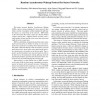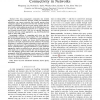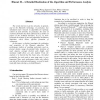364 search results - page 32 / 73 » Shortest-path network interdiction |
BROADNETS
2004
IEEE
13 years 11 months ago
2004
IEEE
This paper presents Random Asynchronous Wakeup (RAW), a power saving technique for sensor networks that reduces energy consumption without significantly affecting the latency or c...
TKDE
2010
13 years 6 months ago
2010
— The data management community has recently begun to consider declarative network routing and distributed acquisition: e.g., sensor networks that execute queries about contiguou...
ISPAN
2005
IEEE
14 years 1 months ago
2005
IEEE
We design a self-stabilizing cluster routing algorithm based on the link-cluster architecture of wireless ad hoc networks. The network is divided into clusters. Each cluster has a...
ICANN
2001
Springer
14 years 1 days ago
2001
Springer
Auditory onsets are robust features of sounds: because the direct path from sound source to ear is the shortest path, the onset is unaffected by reverberation. Many cells in the c...
HICSS
2003
IEEE
14 years 26 days ago
2003
IEEE
The recent interest in ad hoc networks, in general, and in the Bluetooth technology, in particular, has stimulated much research in algorithms for topology control of such network...



